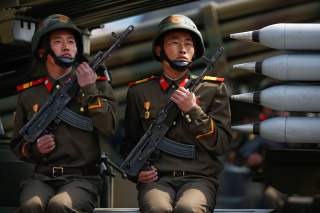North Korea Almost Started a Nuclear War When It Captured a U.S. Spy Ship
The story of the USS Pueblo.
The American crew was eventually moved to a better facility, where they were inundated with propaganda videos. The sailors attempted to clandestinely resist by formulating oddly worded confessions and flipping their middle fingers when posing for photos, which they explained was a “Hawaiian Good Luck” sign to their interrogators. Unfortunately, a Time magazine article eventually gave this ploy away to their captors, who subjected the prisoners to a week of brutal torture as a punishment.
Meanwhile, U.S. diplomats were slogging through months of negotiations at the border village of Panmunjom—talks slowed down by the North Korean negotiator being forced to read his points from cards, lacking the permission to formulate his own replies to American offers. Pyongyang was completely unwilling to return the Pueblo, and would only return the crew in exchange for a signed apology, a confession of guilt from the U.S. government, and a promise never to spy on North Korea again.
U.S. negotiator Gen. Gilbert Woodward struck on a way of making this demand palatable: in a gesture of mutual bad faith agreed upon in advance, the United States told the North Koreans it would sign such a document with the understanding it would retract the confession as soon as the crew of the Pueblo was returned. Kim Il-sung’s negotiator found this acceptable.
The eighty-two surviving crew members and one body were bussed down to the border crossing at the Bridge of No Return on December 23, 1968, exactly eleven months after the North Korean attack, where they walked back into American hands. As promised, Washington promptly rescinded its apology.
The crew was given a jubilant reception upon their return to the United States, but Captain Bucher was made to sit before a Navy court of inquiry. “Don’t give up the ship!” is an unofficial rallying cry of the U.S. Navy, and to the admirals of the court, Bucher had committed a cardinal sin when he surrendered his nominally armed vessel—even though attempting to shoot back would simply have led to the slaughter of the Pueblo’s crew. The admirals recommended a court martial, perhaps unmindful of an earlier classified report that found the U.S. Navy leadership culpable for sending the Pueblo, unprepared and unsupported, into a dangerous situation. Navy Secretary John Chafee, however, declined to press charges, telling the press that “they have suffered enough.”
The capture of the Pueblo marked a worst-case disaster scenario for U.S. intelligence, as the ship had carried a dozen top-secret encryption machines and coding cards. North Korea is believed to have flown eight hundred pounds of equipment from the Pueblo to Moscow, where it was reverse engineered, allowing the Soviets to tap into U.S. naval communications. The U.S. Navy was erroneously comforted by the belief that the Soviets lacked the new codes necessary to decrypt those signals, not realizing that the John Walker spy ring had just begun to furnish these to Moscow. This left U.S. naval communications compromised for nearly two decades.
The assumption that the Pueblo incident was orchestrated by Moscow was ill founded, however. Though the Soviet Union was committed by treaty to come to North Korea’s defense, the Brezhnev government made clear it would not enter into war with the United States over a provocation from Pyongyang. Diplomatic communiqués released after the end of the Cold War reveal that Moscow was upset by the North Korean attack, which may have been egged on by promises of support from China, which was attempting to secure Pyongyang’s loyalty in the bitterly divided Eastern Bloc. A week after the Pueblo was captured, Kim Il-sung demanded additional economic aid from Moscow—a request which was reciprocated in a bid to pay off the North Korean leader into deescalating tensions with the United States.
Although Pyongyang profited from playing one patron against the other, its attack on the Pueblo was probably primarily motivated by the failure of its assassination plot in South Korea. Anticipating possible attacks from South Korea or the United, it may have seen taking the Pueblo as a preemptive move in an imminent conflict, or as a means to gain leverage over Washington and sow dissension between the United States and South Korea.
Many of the Pueblo’s crew went on to suffer from post-traumatic stress disorder and lifelong physical injuries. Over time, however, the crewmembers put up their own website testifying to their experiences, successfully lobbied for status as prisoners of war after it was initially denied to them, and sued North Korea in U.S. court for their treatment. As for the Pueblo itself, technically the second oldest ship still commissioned in the U.S. Navy, it remains in North Korean custody to this day. It is currently moored off the Potong River in Pyongyang, where it serve as an exhibition of the Victorious Fatherland Liberation War Museum.
Sébastien Roblin holds a master’s degree in conflict resolution from Georgetown University and served as a university instructor for the Peace Corps in China. He has also worked in education, editing and refugee resettlement in France and the United States. He currently writes on security and military history for War Is Boring.
This first appeared in 2016.

